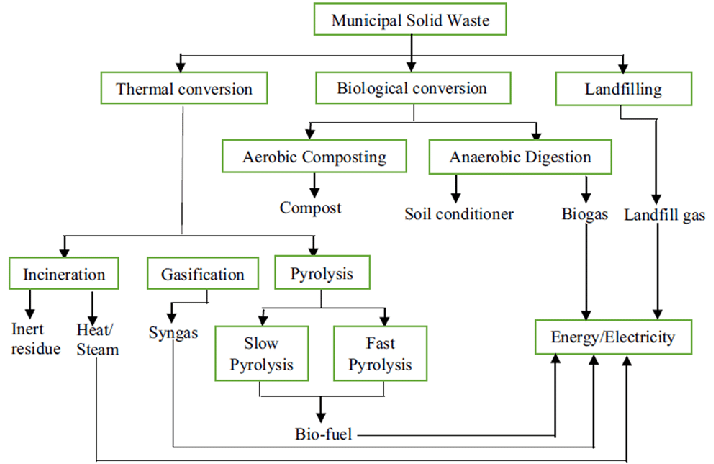Biodiversity & Environment
Waste to Energy
- 23 Mar 2023
- 7 min read
For Prelims: Waste-to-Energy, Solid Waste Management, Biodegradable and Non-Biodegradable Organic Waste.
For Mains: Waste-to-Energy.
Why in News?
The Kerala government recently announced the State’s first Waste-To-Energy project in Kozhikode. The planned facility is expected to be built in two years and generate about 6 MW of power.
- Kozhikode has a population of about 6.3 lakh and generates approximately 300 TPD of waste. Of this, around 205 TPD is biodegradable and 95 TPD is non-biodegradable.
- There are around 100 waste-to-energy projects around the country but only a handful of them are operational, thanks to various production and operation challenges.
What do Waste-to-Energy Projects do?
- Waste-to-energy projects use non-recyclable dry waste to generate electricity and ease the Solid Waste Management (SWM) burden.
- Solid waste in India is 55-60% biodegradable organic waste, which can be converted into organic compost or biogas; 25-30% non-biodegradable dry waste; and around 15% silt, stones, and drain waste.
- Of the non-biodegradable dry waste, only 2-3% – including hard plastics, metals, and e-waste – is recyclable.
- The remainder consists of low-grade plastic, rags, and cloth that can’t be recycled.
- This fraction of the non-recyclable dry waste is the most challenging portion of the present SWM system; the presence of these materials also reduces the efficiency of recycling other dry and wet waste.
- Waste-to-energy plants use this portion to generate power. The waste is combusted to generate heat, which is converted into electricity.
What is Waste-to-Energy Technologies?
- Biological Treatment Technologies (BTT):
- BTT are designed and engineered for natural biological processes working with the organic rich fraction of Municipal Solid waste. These treatments are divided into two different processes:
- The aerobic process or composting (in the presence of oxygen) and the anaerobic process (in the absence of oxygen).
- BTT are designed and engineered for natural biological processes working with the organic rich fraction of Municipal Solid waste. These treatments are divided into two different processes:
- Thermal Treatment Technologies:
- The thermal treatment of hazardous waste involves pyrolysis, gasification, and incineration techniques, depending upon the nature of the waste and the end-product application.
- Pyrolysis is the heating of an organic material, such as biomass, in the absence of oxygen. Biomass pyrolysis is usually conducted at or above 500 °C, providing enough heat to deconstruct the strong biopolymers.
- Gasification is a process that converts organic or fossil-based carbonaceous materials at high temperatures (>700°C), without combustion, with a controlled amount of oxygen and/or steam into carbon monoxide, hydrogen, and carbon dioxide.
- Incineration is a rapid oxidation process, which is used to convert VOCs (Volatile Organic Compounds) and other gaseous hydrocarbon pollutants to carbon dioxide and water.
- Torrefaction converts biomass in the absence of oxygen at a temperature of 200–300°C to produce torrefied materials, bio-oils, biochar, etc.
- The thermal treatment of hazardous waste involves pyrolysis, gasification, and incineration techniques, depending upon the nature of the waste and the end-product application.
What are the Challenges Related to Such Plants?
- Low Calorific Value:
- The low calorific value of solid waste in India due to improper segregation. The calorific value of mixed Indian waste is about 1,500 kcal/kg, which is not suitable for power generation.
- The calorific value of segregated and dried non-recyclable dry waste is much higher, at 2,800-3,000 kcal/kg, sufficient to generate power. However, segregation should be streamlined to ensure the waste coming to the facility has this calorific value.
- High Costs of Energy Production:
- The cost of generating power from waste is around Rs 7-8/unit, while the cost at which the States’ electricity boards buy power from coal, hydroelectric, and solar power plants is around Rs 3-4/unit.
- Improper Assessments:
- Many waste-to-energy projects have failed because of improper assessments, high expectations, improper characterisation studies, and other on-ground conditions.
What are the Related Initiatives?
What can be the Solution?
- While State electricity boards are considering purchasing power from newer renewable energy sources like waste-to-energy, the price of the power generated needs to halve.
- Setting up waste-to-energy projects is complex and needs the full support of the municipality, the State and the people. To overcome its various challenges, the municipality must ensure that only non-biodegradable dry waste is sent to the plant and separately manage the other kinds of waste.
- Importantly, the municipality or the department responsible for SWM should be practical about the high cost of power generation, and include the State electricity department, perhaps as a tripartite agreement between the municipality, the plant operator, and the power distribution agency.
- It is also crucial to conduct field studies and learn from the experience of other projects.
- Without all these efforts, the project may not be a success, which in turn will stress the State government to manage all the accumulated waste, which can be a costly mistake.
UPSC Civil Services Examination, Previous Year Question (PYQ)
Prelims
Q. In the context of which one of the following are the terms ‘pyrolysis and plasma gasification’ mentioned? (2019)
(a) Extraction of rare earth elements
(b) Natural gas extraction technologies
(c) Hydrogen fuel-based automobiles
(d) Waste-to-energy technologies
Ans: (d)
Mains
Q. What are the impediments in disposing the huge quantities of discarded solid waste which are continuously being generated? How do we remove safely the toxic wastes that have been accumulating in our habitable environment? (2018)





